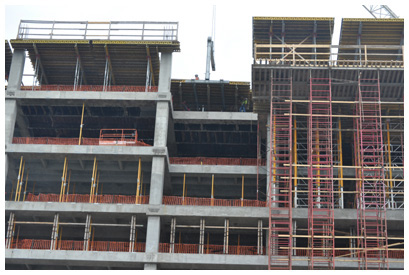June employment, May spending rise for construction; most metros add jobs in May Editor’s note: Construction Citizen is proud to partner with AGC America to bring you AGC Chief Economist Ken Simonson's Data DIGest. Check back each week to get Ken's expert analysis of what's happening in our industry.
Editor’s note: Construction Citizen is proud to partner with AGC America to bring you AGC Chief Economist Ken Simonson's Data DIGest. Check back each week to get Ken's expert analysis of what's happening in our industry.
Nonfarm payroll employment rose by 288,000, seasonally adjusted, in June and 2,495,000 (1.8%) over 12 months, the Bureau of Labor Statistics (BLS) reported last Thursday. Construction employment rose by 6,000 for the month and 186,000 (3.2%) over the year to 6,015,000, the highest total since June 2009. Residential construction employment (residential building and specialty trade contractors) climbed by 6,600 for the month and 106,300 (4.9%) for the year. Nonresidential employment (building, specialty trades, and heavy and civil engineering construction) was flat in May and up 80,000 (2.2%) year-over-year. All five residential and nonresidential segments added workers over 12 months. Aggregate hours worked in construction increased 3.2% over 12 months, while average hourly earnings rose 2.3%. The unemployment rate for jobseekers who last worked in construction fell to the lowest June level in six years: 8.2%, down from 9.8% in June 2013 and a high of 20.1% in June 2010. (Industry unemployment data are not seasonally adjusted and should only be compared year-over-year, not across months.) Since June 2010 the number of unemployed construction workers has dropped by 1,075,000, not seasonally adjusted. But construction employment rose by only 512,000, implying that over 500,000 experienced workers in the past four years left the industry for employment elsewhere, further training or schooling, retirement, or left the workforce. These departures in June make it hard for contractors to find skilled workers if demand rises further, even though the unemployment rate remains higher than the overall nonfarm rate (6.1%, not seasonally adjusted; 6.3%, seasonally adjusted).
Construction spending in May totaled $956 billion at a seasonally adjusted annual rate, up 0.1% from April and up 6.6% from May 2013, the Census Bureau reported last Tuesday. Census revised up the totals for 2013 (by $11 billion) and 2012 ($4 billion); the revised 2013 growth rate was 5.7%. Private residential spending dropped 1.5% for the month but rose 7.5% over the latest 12 months and 20% in 2013. Private nonresidential spending climbed 1.1% for the month, 11 % over the past 12 months and 1.2% in 2013. Public construction spending gained 1.0% in May and 1.2% over the latest 12 months after falling 3.5% in 2013. Of the three residential components, new single-family construction slid 1.4% in May but increased 11% year-over-year; new multifamily, -0.6% and 31%, respectively; and improvements to existing residential structures, -1.9% and -2.5%. After receiving new or corrected information about wind power and pipeline projects, Census boosted estimated 2014 power construction (including conventional and renewable power plus oil and gas fields and pipelines). May spending was up 4.3% from April and 30% from May 2013. The next three private segments (in descending order of current size) were mixed for the month but up year-over-year: commercial (new and renovated retail, warehouse and farm), -0.6% and 6.5%; and office, 0.1% and 23%. Of the top two public segments, highway and street construction increased 0.7 % for the month and 2.3% over 12 months, while public educational spending slipped 0.6% from April but gained 1.7% year-over-year.
The ostensible rebound in office construction may be due more to renovation than new construction. “Employers have only reoccupied about 52% of the 142 million square feet that went vacant amid the economic downturn, with occupancy in the second quarter growing by 2.8 million square feet, according to numbers…from real-estate-data firm Reis Inc.,” the Wall Street Journal reported on Tuesday. “The office vacancy rate remained unchanged in the second quarter at 16.8%, still near its post-recession peak of 17.6% in 2010 and well above the 12.5% rate in 2007….during this economic cycle, companies have been more reluctant than usual to expand, which many in the sector believe reflects a trend by companies to pack a greater number of employees into tighter spaces.”
From May 2013 to May 2014, construction employment increased in 218 out of 339 metropolitan areas for which the Bureau of Labor Statistics reports construction data, declined in 72 and was unchanged in 49, according to an analysis that AGC released last Monday. (The agency combines mining and logging with construction in most metros to avoid disclosing data for industries with few firms. Because metro data is not seasonally adjusted, comparisons with months other than May are not meaningful.) Dallas-Plano-Irving added the largest number of construction jobs in the past year (11,100 combined jobs, 10%); followed by the Los Angeles-Long Beach-Glendale division (9,300 construction jobs, 8%); Houston-Sugar Land-Baytown (7,300 construction jobs, 4%); the Santa Ana-Anaheim-Irvine division (7,200 construction jobs, 9%) and Atlanta-Sandy Springs-Marietta (7,100 construction jobs, 8%). The largest percentage gains occurred in St. Cloud, Minn. (34%, 1,700 combined jobs); Monroe, Mich. (30%, 700 combined jobs); and El Centro, Calif. (29%, 600 combined jobs). The Bethesda-Rockville-Frederick, Md. division experienced the largest job loss (-4,200 combined jobs, -13%); followed by the Gary, Ind. division (-2,800 construction jobs, -14%) and Virginia Beach-Norfolk-Newport News, Va.-N.C. (-2,000 combined jobs, -6%). The largest percentage decline for the past year occurred in Cheyenne, Wyo. (-14%, -500 combined jobs) and Gary, followed by Vineland-Millville-Bridgeton, N.J. (-13%, -300 combined jobs) and Bethesda-Rockville-Frederick.
The Data DIGest is a weekly summary of economic news; items most relevant to construction are in italics. All rights reserved. Sign up at www.agc.org/datadigest.
AGC's Data DIGest: June 30-July 3, 2014
by Ken Simonson | July 07, 2014



Add new comment